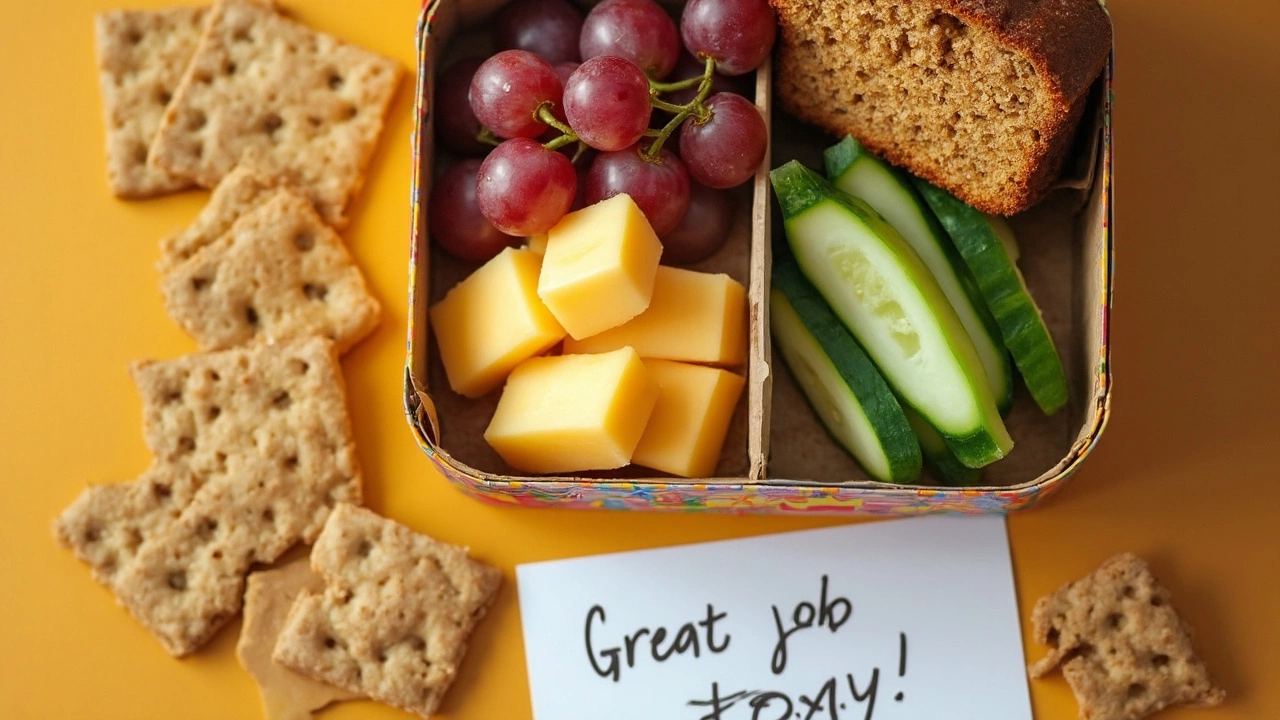Do 10 Year Olds Need Snacks? What After-School Clubs Should Know
Kids sprint out of school at 3:30, but you can almost hear their stomachs rumbling before they even get to the after-school club. If you’ve ever run or volunteered at one, you know how wild that first hour can get—part energy, part hunger. At 10 years old, kids are growing fast, and school takes a lot out of them. They need a boost, but not just any food will do.
Snacks aren’t just a treat for this age. A lot of 10-year-olds have lunch around midday but then go several hours before dinner. That’s a big gap, especially since most after-school club activities—from sports to art—are extra demanding. Quick energy is key, but so is picking the right type of fuel. Handing out cookies or chips might sound easy, but it usually means sugar highs and crashes, not steady energy.
So, what should you give them instead? Think snacks that mix carbs with protein and a little healthy fat. Stuff like apple slices with peanut butter, small wholegrain wraps, cheese and crackers, or even some trail mix (without loads of chocolate). These combos keep kids fuller for longer and help them focus on whatever the club is doing—whether it’s homework help or basketball.
- Why Snacks Matter for 10 Year Olds
- How After-School Clubs Change Snack Needs
- Best Snack Choices: Simple and Smart
- Warning Signs: When Snacks Turn into Sugar Bombs
- How to Organize Snack Time that Actually Works
Why Snacks Matter for 10 Year Olds
It’s pretty simple: 10 year olds are constantly burning energy. Between school, sports, play, and just growing, their bodies need regular fuel. By this age, most kids need around 1,600–2,200 calories per day—more if they’re extra active. But school schedules usually leave a big gap between lunch and dinner, making that after-school window super important for refueling.
Skipping snacks isn’t a great idea for kids in this age group. Without a little extra energy after school, you’ll see kids fade fast—less focus, less motivation, and sometimes more grumpiness. For after-school clubs, where activities can get physical or require concentration, the right snack can actually help kids take part and keep up with everyone else. The American Academy of Pediatrics points out that snacks are a key way to ensure kids meet their daily nutrition needs, especially for nutrients that aren’t always packed into their main meals.
Here’s what snacks really do for kids nutrition at this age:
- Boost brainpower: Hunger can mess with concentration. A snack keeps minds sharp for homework or club activities.
- Fend off energy crashes: After school is prime time for low energy. A balanced snack means fewer meltdowns and better moods.
- Support healthy growth: Kids’ bodies are changing fast. Regular food helps bones, muscles, and brains grow how they should.
Curious how many 10 year olds really need snacks? A small UK study from 2022 found that 75% of kids said they felt hungry right after school at least three times a week. It’s not just a feeling—it’s basic biology. They’re just wired to recharge mid-afternoon.
| Age | Average Calories Needed Daily | Common School Lunch Time |
|---|---|---|
| 10 | 1,600-2,200 | 12:00 - 1:00 PM |
The bottom line? If you want kids to show up ready for anything—sports, clubs, or homework—snacks aren’t optional. They’re a basic part of keeping kids fueled and happy.
How After-School Clubs Change Snack Needs
Once the school bell rings, the game changes. After-school clubs make snack needs even more important. It's not just about filling empty tummies—now kids are using up extra energy playing sports, making crafts, or focusing on projects. A plain old cookie just doesn't cut it, especially for active kids who burn through calories fast.
Kids in after-school programs are often there for one to three extra hours. Toss in basketball practice or drama rehearsal and you’re talking about serious energy output. Some after-school clubs have done studies showing that students in just one hour of steady movement can burn up to 150 calories—about the same as a small sandwich or a big banana. And that doesn’t count the mental effort involved in activities like coding club or chess.
But there’s something else. Kids this age don’t always remember to drink water, so snacks work better when paired with water to help them stay hydrated and sharp. Clubs that give out high-sugar or salty snacks usually see kids lose focus or complain about being tired later—it’s a pattern most club leaders spot pretty fast.
Look at the needs of different clubs:
- Sports clubs: Need quick energy snacks and more hydration due to sweat and activity.
- Homework/study clubs: Focus on foods that help with concentration, like fruits paired with cheese or unsweetened yogurt.
- Creative clubs (art, drama, music): Steady energy is key, so pick snacks that don’t spike blood sugar and cause mood swings.
Here’s a quick look at snack energy in action:
| Activity | Calories Burned/Hour (Avg. 10-year-old) | Snack Example to Refuel |
|---|---|---|
| Soccer/Active Sports | 120-160 | Wholegrain wrap with turkey, piece of fruit |
| Art/Crafts | 40-60 | Crackers with cheese, small handful of grapes |
| Homework/Study | 30-50 | Banana with nut butter |
Bottom line: the right snack can keep kids happier, more focused, and ready to make the most out of their club time. After-school clubs should plan snacks based on what the kids actually do, not just what’s easiest to hand out.

Best Snack Choices: Simple and Smart
When you’re picking snacks for 10 year olds, especially in after-school clubs, you want options that actually help kids—not just fill them up for five minutes. The best snacks mix some carbs for quick energy with protein and healthy fat for lasting power. That combo stops them from getting hangry and helps them focus longer, whether they're building a robot or kicking a soccer ball.
If you want go-to ideas, here are solid options that most kids like and you can prep fast:
- Apple slices with nut butter (peanut, almond, or sunflower seed for allergy-safe spaces)
- Whole wheat pita bread with hummus
- Cheese sticks with wholegrain crackers
- Homemade trail mix (nuts, seeds, wholegrain cereal, a sprinkle of raisins; skip or limit chocolate chips)
- Greek yogurt with fresh fruit and a spoonful of oats
- Veggie sticks (carrot, cucumber, bell pepper) with dip
- Mini turkey or chicken wraps
Watch the portion sizes. Kids need fuel, not a meal, so keep it about the size of their fist. Nutrition pros, like the American Academy of Pediatrics, say snacks shouldn’t push kids over their daily calories—just keep them steady until dinner.
Want to see how classic "junk" snacks stack up against healthier choices? Here’s a quick comparison:
| Snack Option | Calories | Sugar (g) | Protein (g) | Added Benefits |
|---|---|---|---|---|
| Cookies (3 medium) | 180 | 14 | 2 | Quick energy spike, fast crash |
| Apple & Nut Butter | 130 | 8 (all natural) | 3 | Filling, vitamins, slower energy release |
| Cheese & Crackers | 140 | 3 | 5 | Calcium, protein, keeps kids full |
The takeaway? Skip sugary, processed snacks when you can. Whole foods beat the pre-packed stuff almost every time. With a little planning, you can give kids in your after-school club snacks that keep them happy, full, and actually ready to do stuff—not just bounce off the walls.
Warning Signs: When Snacks Turn into Sugar Bombs
Ever seen a group of 10 year olds bouncing off the walls, then suddenly totally wiped? That’s classic sugar overload in action. It usually happens when their snacks are stuffed with simple sugars, like the kind in cookies, soda, or even some granola bars. Too much sugar hits fast, spiking energy, but it also drops quickly—making kids cranky, tired, and less focused on after-school club activities.
Not all snacks are easy to spot as sugar bombs. Words like "fruit-flavored," "yogurt-coated," or even "energy bar" sound healthy, but they can pack as much sugar as candy. Here are some red flags to watch out for with snacks for 10 year olds:
- Snacks with 10g or more of added sugar per serving—check nutrition labels. The American Heart Association recommends no more than 25g of added sugar a day for kids, so one snack can eat up a big chunk fast.
- Ingredients like corn syrup, fructose, or anything ending in “-ose” high on the ingredients list.
- Bright, cartoon packaging pushing dessert-like flavors. If it looks like a treat, it probably is.
- Beverages like sports drinks, juice boxes, or flavored milk. Water always beats these for after-school thirst.
If you're curious how some common snack choices stack up, take a look at this quick breakdown:
| Snack | Added Sugar (per serving) |
|---|---|
| Packaged granola bar | 11g |
| Fruit gummies | 14g |
| Apple slices & peanut butter | 2g |
| Cheese & wholegrain crackers | 1g |
| Chocolate pudding cup | 18g |
The bottom line? If a snack leaves kids hyped one minute and dragging the next, take a closer look at those sugar numbers. Sticking with balanced, lower-sugar foods helps them keep steady energy and actually enjoy their time at the after-school club.

How to Organize Snack Time that Actually Works
If you’re running an after-school club, you know chaos breaks out quick if you don’t have a plan, especially when it comes to snacks. Here’s how to keep things smooth and make sure every kid gets the boost they need without drama.
First, set a clear snack time. Kids do better with routines. Slot it right after arrival or before the main activity kicks off. If you mix up the schedule each day, expect confusion, complaints, and random snack ransacking.
Next, make sure snack options are set out and ready. Try prepping plates or snack stations ahead of time. This cuts down on waiting, which is also when those pre-dinner grumbles get loudest. If you work with more than ten kids, it saves sanity to serve snack in small groups instead of a crowd mobbing the table at once.
Label everything if you’ve got kids with allergies or food rules. Ask parents about allergies during registration and keep a list handy. Big, clear labels on foods go a long way—so does having backup snacks for kids with special needs.
Don’t forget hydration. Water is just as important as food, especially after sports or outdoor activities. Set out reusable cups and a big water jug—or just hand out bottles if it’s easier to manage.
It sounds basic, but handwashing matters. Remind kids to clean their hands before diving in. Maybe work it into your routine with a funny handwashing song or a quick game to keep it from feeling like a chore.
Here’s a handy breakdown of snack time basics:
- Set snack time at the same time each club day
- Prep snacks in advance
- Label all foods for allergies
- Divide kids into small groups for serving
- Make water easy to access
- Enforce handwashing before eating
If you want to see how well you’re doing, check in with the kids—ask what snacks they like and notice if energy or focus tanks after certain foods. A 2023 survey by Afterschool Alliance showed that 64% of kids said their favorite after-school clubs always had snack time, and those clubs had better attendance. It’s clear: Good snack choices and a solid plan keep everyone happier.







